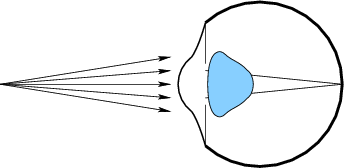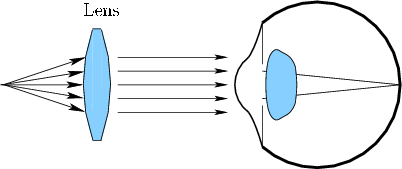
Next: Accommodation Up: 4.4 The Human Eye Previous: 4.4 The Human Eye Contents Index
The outer diameter of the eyeball is roughly ![]() mm, which implies that a lens of at least
mm, which implies that a lens of at least ![]() D would be required to cause convergence of parallel rays onto the retina center inside of the eye (recall diopters from Section 4.2). There are effectively two convex lenses: The cornea and the lens. The cornea is the outermost part of the eye where the light first enters and has the greatest optical power, approximately
D would be required to cause convergence of parallel rays onto the retina center inside of the eye (recall diopters from Section 4.2). There are effectively two convex lenses: The cornea and the lens. The cornea is the outermost part of the eye where the light first enters and has the greatest optical power, approximately ![]() D. The eye lens is less powerful and provides an additional
D. The eye lens is less powerful and provides an additional ![]() D. By adding diopters, the combined power of the cornea and lens is
D. By adding diopters, the combined power of the cornea and lens is ![]() D, which means that parallel rays are focused onto the retina at a distance of roughly
D, which means that parallel rays are focused onto the retina at a distance of roughly ![]() mm from the outer cornea. Figure 4.26 shows how this system acts on parallel rays for a human with normal vision. Images of far away objects are thereby focused onto the retina.
mm from the outer cornea. Figure 4.26 shows how this system acts on parallel rays for a human with normal vision. Images of far away objects are thereby focused onto the retina.
 |
 |
Steven M LaValle 2020-01-06